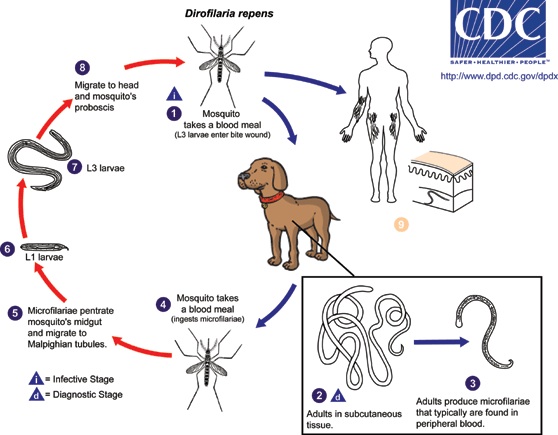Most of the time, when we talk about the parasite Dirofilaria in animals, we’re talking about Dirofilaria immitis – a.k.a. heartworm. However, it’s not the only member of this parasite family that is found in dogs and cats. Another one, Dirofilaria repens, is present in pets in many regions, and it can also spread to people via mosquitoes.
A recent report from Belarus, highlighted in ProMed-Mail, describes 21 cases of dirofilariasis caused by D. repens. Interestingly, this is a relatively new finding for the area, as the disease was not reported in Belarus before the mid-1990s.
This parasite naturally infects dogs, cats, and a variety of wild carnivores like wild canids (e.g. wolves, coyotes, foxes). Mature worms live in tissues under the skin of a suitable host, where they produce larvae (microfilaria). These larvae enter the bloodstream and can then be taken up by mosquitoes that bite the host. If a mosquito feeds on an infected animal and then a person, it’s possible to transfer the larvae to the person. People aren’t natural hosts, and the parasite almost never develops into its adult state. However, as the parasite undertakes its futile migration through a person’s tissues, trying to find a place to mature, the body mounts an immune response. This results in local inflammation, typically causing the development of little tissue nodules. Very rarely, more serious infections can occur, in which case surgical excision of the nodule, with or without antiparasitic drugs, is the typical treatment.
Heartworm prevention practices should also prevent establishment of D. repens infections in dogs. Control of the parasite in the dog population is an important control measure in areas where it exists, but if the parasite is also present at high levels in wild animals, that complicates things. Basic mosquito control and avoidance measures also make sense. 
Image source: http://www.cdc.gov/dpdx/dirofilariasis/index.html